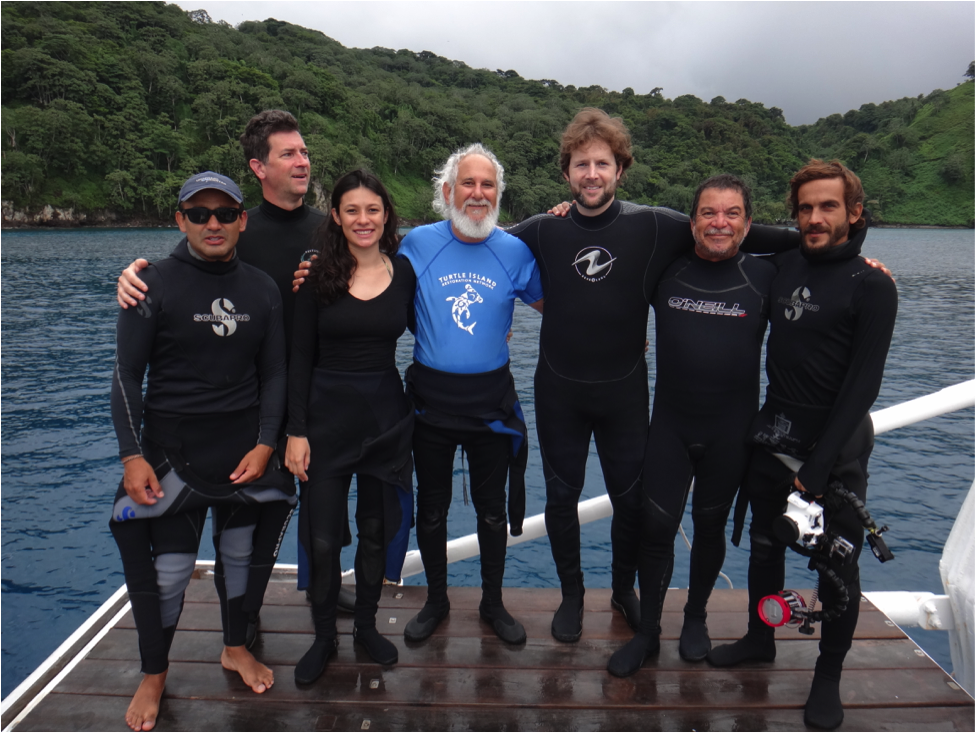Editor’s Note: Cocos Island National Park, Costa Rica is located 350 miles from the mainland in the Pacific Ocean and is a U.N. World Heritage Site. The waters of Cocos are highly diverse and have one of the highest biomasses of fish found anywhere in the world. It is also an important no-fishing sanctuary for many species of highly migratory species including large populations of hammerhead and other sharks. Turtle Island is involved in a study of its marine fauna focusing on sharks and turtles. This is blog 1 of 4 from the expedition.
The 36-hour crossing to Cocos Island started with good omens for an exciting trip! The seas were smooth and we were accompanied part of the time by a pod of acrobatic spotted dolphins riding the bow waves. We also slowed to watch one of the two humpback whales spotted en route, taking time out from reviewing research protocols, preparing shark tags, and assembling other research equipment.

L to R: Mark, Randall & Todd.
Our second good omen, predicting that this was going to be a productive trip, started with our first “check out” dive in Manuelita Coral Garden. Even though water temps were high (840F), we were greeted by about six hammerhead sharks, which normally are found in the deep cooler waters surrounding Cocos Island. Since they seemed curious, we had the opportunity to view them at close range. We also observed a tiger shark, white-tip sharks, marbled rays, and a myriad of bony fish and moral eels.
One concerning observation was that at least 50 percent of the coral above 50 feet was bleached, a phenomena we documented at all the shallower dives sites around Cocos Island on this trip. Coral bleaching is the result of the unusually warm El Nino waters occurring throughout the Eastern Pacific. When water is too warm, corals will expel the algae (zooxanthellae) living in their tissues causing the coral to turn completely white. Though bleached corals are not dead and can survive a bleaching event, they are under more stress and are subject to increased mortality. Interestingly, over the years, we have also observed bleaching events at Cocos Island caused by low water temperatures too. The good news is that as the week went on, the thermocline appeared with lower temperatures (73-780 F) below 100 feet.

This photo shows coral bleaching.
Our research team for this expedition consisted of Randall Arauz, Turtle Island’s international policy director and myself (co-principal investigators), accompanied by four research assistants: Mark Stabb, who has accompanied us on nine(!) Cocos expeditions; Elpis Chavez, a graduate student studying sharks in Costa Rica (from Mexico) on her second expedition with us; Nestor Rago, a graduate student studying manta rays in Costa Rica (from Argentina) and an amazing underwater photographer; Bryan Chadwick, a Turtle Island member; and Edwar Hereno, a marine biologist who worked at Cocos as a divemaster for 12 years and who has 9000+ Cocos dives under his belt. Edwar is a member of Turtle Island’s scientific advisory board, and is also a professional underwater photographer/videographer.

Our fantastic research team.
Both Elpis and Nestor were able to participate due to our scholarship. Please consider contributing to our Cocos Island scholarship program, which allows deserving (low income) students and early career scientists to participate on Cocos expeditions. Please email tsteiner@tirn.net if you are interested in contributing to the scholarship fund.

Scholarship recipients Elpis and Nestor. (Photo by Joan Chavez).
Coming up: Tomorrow’s blog will tell and show you in photographs and videos about diving in a “bait ball,” one of the most incredible opportunities most divers only get to dream of experiencing! Read blog 2 by clicking here.
Interested in joining our next expedition? Learn more here!




